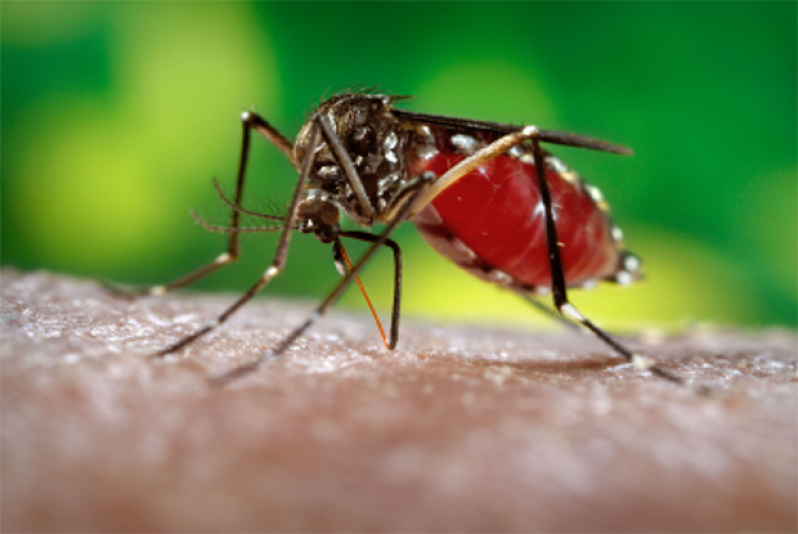PRESIDENT Donald Ramotar on Saturday reiterated the sentiments of Pan-American Health Organisation/World Health Organisation (PAHO) Representative for the Guyana Country Office, Dr. William Adu-Krow, who was the most recent official to laud local health workers for their efforts to curtail the incidence of Chikungunya in Guyana.
And he called on Guyanese to play their role in assisting to reduce the number of Chikungunya cases by controlling the spread of the illness, whose first indigenous transmission in the Americas was confirmed on December 6, 2013.
The Chikungunya virus, which is transmitted by the bites of Aedes aegypti and Aedes albopictus mosquitoes, causes high fever, joint pain, rash, headache, and muscle pain.
“I know that they (health workers) are doing a lot of work. I know that the health workers are doing work all over the country…I admire the work they are doing, but a lot of it has to do with our role too,” he said at a press conference on Saturday at Sate House.
According to PAHO, there are three factors for rapid transmission that have also been documented in other countries: 1) It is a new virus in the Americas; 2) Since it is a new virus, defences have not been built against it and the entire population is susceptible to Chikungunya; and 3) the Aedes mosquito is widely distributed in the Region due to the climatic, temperature, and moisture conditions of tropical countries.
To this end, the recommended measures to ensure that the mosquito’s breeding sites are eliminated or destroyed include:
* Avoiding the storage of water in outdoor receptacles (plant pots, bottles, containers that can collect water) to prevent them from becoming mosquito-breeding sites;
* Covering domestic water tanks or reservoirs so that mosquitoes do not get in;
* Avoiding the build-up of garbage, which must be put into closed plastic bags and kept in closed containers.
* Uncovering/unblocking drains to release stagnant water; and
* Using mosquito mesh/netting in windows and doors to help reduce contact between mosquitoes and people.
PAHO, in a recent statement said, “We have to see our people take greater interest, given the breeding of mosquitoes. The elimination and control of the mosquito breeding sites reduces the likelihood of the Chikungunya and dengue viruses being transmitted.”
[box type=”shadow” align=”alignright” ]“We have to see our people take greater interest, given the breeding of mosquitoes. The elimination and control of the mosquito breeding sites reduces the likelihood of the Chikungunya and dengue viruses being transmitted.” – PAHO[/box]
INCREASING NUMBERS
Guyana, according to PAHO, has an incidence of 2.0 per 100,000 of Guyanese and as at July 25 there were 16 confirmed cases.
However, the PAHO Representative for the Guyana Country Office last Tuesday stated that he has information suggesting that Guyana has approximately 60 cases of persons infected with the Chikungunya virus.
“Officially I am told that it is still 16, unofficially I am told in confidence that we have about 60 cases and that is because we are not testing everybody,” Dr. Adu-Krow said.
Asked to comment on the increasing numbers, the President said the PAHO numbers are not the Ministry of Health’s numbers.
He told the Guyana Chronicle that efforts are ongoing to ensure that the spread of the illness is brought under greater control, including indoor and outdoor fogging.
Additionally, once the illness is suspected, samples are taken and sent to the Caribbean Public Health Agency (CARPHA) in Trinidad and Tobago for confirmation.
Cases of Chikungunya virus have been reported in Regions 3, 4, and 5.
The disease rarely causes death, but joint pain can last months or even years for some people. Complications are more frequent in children under 1 and in people over 65 years of age and/or with chronic diseases (diabetes, hypertension, etc.).
There is no specific treatment or vaccine to prevent infection by this virus and symptomatic treatment controls the pain and fever. Once a person has contracted the illness, protective antibodies are developed and, according to the scientific evidence available to date, there should be life-long immunity once this happens.
The disease was first reported in the Caribbean in December 2013, and has since touched Anguilla, Antigua and Barbuda, British Virgin Islands, Dominica, Dominican Republic, El Salvador, French Guiana, Grenada, Guadeloupe, Guyana, Haiti, Martinique, Puerto Rico, Saint Barthelemy, Saint Kitts and Nevis, Saint Lucia, Saint Martin, Saint Vincent and the Grenadines, Saint Maarten, Suriname, Turks and Caicos Islands, and the US Virgin Islands.
Written By Vanessa Narine












